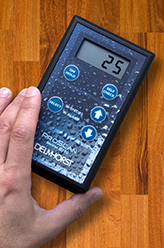With its sound structure and gorgeous appearance, wood makes for the perfect raw material. And flooring professionals are aware that moisture content is the most important factor that affects a proper installation.
Moisture affects the basic structural characteristics and properties of wood. And for this reason, it's important that flooring strips, planks and the sub-floor be brought to equilibrium before installation.
The best results are obtained when the wooden sub-floor is within 4% Moisture Content (MC) of the flooring maximum.
A pinless moisture meter can avoid future flooring problems like buckling and cupping.
In an ideal scenario, wood for flooring installations would be dry and predictable. However, while a good wood flooring installer takes the time to acclimate the wood, there's no way to tell whether it’s at the right moisture level simply by looking at it.
Humidity can affect the relative humidity (RH) of the wood — as can the environment the wood is in — so finding the proper moisture levels is crucial to avoiding buckling, cupping and the need to check your floors after installation.
Pinless moisture meters are non-invasive, portable and are designed to produce fast readings. For the most accurate results, the material you're testing must be at least the width of the scanning area on the bottom of the meter. Otherwise, the meter will not make firm contact with the board and may provide inconsistent or unreliable readings. Pinless meters also need firm contact to a flat surface for accuracy.
Delmhorst's ProScan is a useful pinless moisture meter that is ideal for woodworking applications. It uses a harmless radio frequency to easily measure the percentage of moisture content in the wood.
If you regularly work on wood projects, you already know there are several different types of wood — depending on price, quality and availability. To simplify moisture measurement, the ProScan features a built-in species correction function that eliminates this worry.
Pinless meters use radio frequency signals to penetrate the material being tested. There is no pin intrusion into the surface of the material which eliminates any possible surface damage.
The Delmhorst ProScan Pinless Moisture Meter will quickly and easily identify large areas for high moisture spots. They offer the convenience of testing a large area quickly and help you determine if further testing is needed. A pinless meter may also be used to determine if water-born finishes are dry and ready for a second application.
While a pin type meter uses resistance to measure moisture, a pinless meter uses capacitance. Capacitance is the ability to store an electrical charge within a piece of wood flooring.

A pinless meter has a few limitations that can be solved by using a pin type meter. It will not be able to tell the difference between core and shell moisture content — whereas a pin type moisture meter will.
It's also not the best device to use for measuring moisture gradient. The wood has to have a smooth surface and the measuring area has to be flat. Other than these few exceptions, a pinless moisture meter is an excellent tool for flooring installers.
It's simply a great tool for quickly finding specific problem areas on large areas of wood. Just use it to scan over the surface area and voila! You'll get reliable readings in no time.
For more information on how to make the most out of your pinless moisture meter, contact one of our specialists today!

Comments